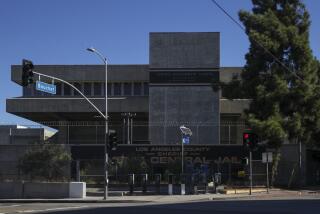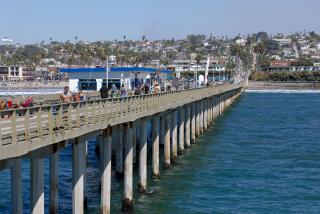Burbank Orders Seismic Tests for Main Terminal at Airport : Safety: A structural analysis is planned to comply with local law. But the building is already set for demolition.
- Share via
Burbank Airport must comply with local seismic-safety law and conduct a structural analysis of its main terminal, despite assurances that it will tear down the building for a new facility in the near future, building officials said Thursday.
In 1991, the airport declined to carry out the detailed engineering analysis required by a Burbank city ordinance, saying the terminal “is probably substantially in compliance already” with earthquake building codes. A thorough study would be a “needless expenditure of public funds” for a structure slated for demolition soon, airport officials said at the time.
But John Cheng of the city building division said Thursday that the airport must heed the ordinance and examine the terminal, which escaped damage in the Northridge earthquake.
Cheng said his office would work cooperatively with airport staff to complete an analysis within 30 to 60 days and then take the next step--either retrofitting or demolition--as promptly as possible.
Airport officials said they are awaiting formal communication from the city before deciding what to do. Spokesman Victor J. Gill stressed that the airport’s own studies in past years have found the main building, Terminal A, to be safe because of constant modifications and strengthening measures since it opened in 1930.
“You literally have backup system after backup system in terms of lateral reinforcement,” Gill said.
The unreinforced masonry covered by the 1990 ordinance involves only a few brick columns, which survived intact in the January temblor, he said. Only Terminal B and the parking structure suffered about $350,000 in damage.
The main terminal is among a handful of sites not in conformity with the ordinance, which mandates analyses and corrections for unreinforced masonry structures built before 1933--about 40 to 50 buildings in all, Cheng said. Owners of buildings not in compliance, including Burbank Airport, should receive reminder letters next week, Cheng said.
The city first notified the airport of the statute in March, 1991. Retrofitting or demolition of the terminal was to be completed by March, 1995.
In a written reply, airport director Thomas E. Greer informed building officials that the facility was already scheduled to be torn down to make way for a new building.
“Given our announced plans to demolish the current terminal we feel it is inappropriate to incur any costs on (analyzing) this facility,” Greer wrote.
Cheng said the promise of demolition and an inspection by the city satisfied his office at the time that there was no need for the airport to mount the study.
“We inspected the building. The masonry portion is a small portion, and we found it was pretty strong at that point,” Cheng said. “That’s why we did not follow through at that time.”
However, delays in constructing the new 670,000-square-foot terminal have pushed back demolition of the current building. Plans call for the new facility to open in 1998, but that now seems unlikely.
If there is to be a delay in demolition, the airport should therefore go ahead and conduct a structural analysis, Cheng said.
“They have to do something,” he said.
*
Gill estimated that a retrofit program, which would entail bolting the columns to the roof and floor, would cost millions of dollars--an unnecessary expense given the improved strength of the building over the years and its performance during the Northridge shaker.
Robert W. Garcin, president of the airport commission, said he would approve retrofitting if it is the only option besides premature demolition.
“We have withstood some pretty major quakes,” he said. “I would retrofit but would be grumbling all the way to the architect’s office and the city to dispute it. I wouldn’t do it willingly.”
Last year, the airport served about 4 million passengers, about 11,000 a day.
More to Read
Sign up for Essential California
The most important California stories and recommendations in your inbox every morning.
You may occasionally receive promotional content from the Los Angeles Times.














